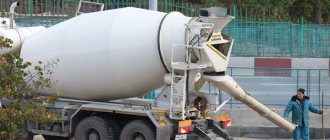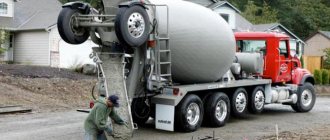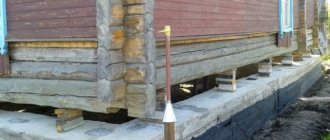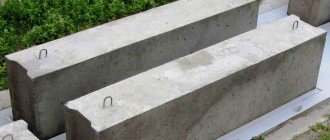- Tape length up to 17 meters
- Concrete supply to a height of up to 6 meters
- Up to 12 cubic meters of concrete per hour
- Low price compared to a concrete pump
The cost of delivering concrete using a mixer with a conveyor belt in Yekaterinburg starts from 4,000 rubles.
Outside the EKAD, in addition to city delivery, each kilometer in both directions is paid at the rate of 45 rubles/km.
The conveyor belt installed on the concrete mixer truck ensures efficient and rapid supply of concrete. When renting a mixer with a conveyor belt, the customer does not need to look for highly specialized equipment.
Delivery of concrete by belt conveyor is relevant when concreting large structures over a long distance. This unloading method is indispensable in cases where:
- It is difficult to get the mixer close to the object.
The use of a conveyor belt ensures high productivity and continuity of the mixture supply process. Unloading a concrete mixer truck with this device is cheaper than renting a concrete pump.
How to deliver concrete over a distance - 6 possible delivery methods
When constructing structures from poured material, concrete is supplied by a concrete pump. Specialized equipment is used at all stages of working with mortar - from production at the enterprise to filling the formwork. Anyone who has had to deal with a tool for creating monolithic structures knows that it is very difficult to do the work manually.
- Types of submission
- Delivery methods
- Concrete pump
- Solution transfer hose
- Conveyor machine
- Road delivery
- Construction crane
- other methods
- What to consider when choosing a method?
The choice of delivery equipment depends on the type of building material. To transport liquid concrete, which has a mobility index of P3 and P4, we use a liquid concrete mixer. The drum rotates uninterruptedly throughout the entire transportation period, which allows maintaining the quality of the concrete solution. Our fleet includes concrete mixer trucks with barrel volumes from 7 to 11 m3. If access at the site is difficult, then pumi can be used for delivery. This is a concrete mixer truck with an installed concrete pump and a distribution boom, 24 or 32 meters long. To deliver semi-dry concrete with mobility indicators P1 and P2 to the site, we use dump trucks. Delivery is carried out by dump trucks with body volumes of 10, 14 and 18 m3.
Concrete is supplied from the mixer 2 meters from the rear axle. If necessary, you can use an additional pipe 5 meters long, as well as a 7-10 meter hydraulic tray. If it is necessary to supply concrete over a longer distance, then we use a concrete pump, which increases the available distance to 52 meters, or a Pumik with a boom of 24 or 32 meters.
Manufacturers
The market is full of various brands from different countries of the world:
- Belarus: MAZ/BelAZ;
- Germany: MAN;
- Netherlands: DAF;
- Sweden: Scania/Volvo;
- USA: Ford/Kenworth;
- Italy: Iveco;
- Korea: Daewoo/Nissan;
- China: Howo/ Dongfeng.
The domestic market is also filled with various brands. Using such products is much easier and more cost-effective. In addition, in the event of a breakdown, the equipment can be repaired directly at the manufacturer’s factory.
- 5/7 cubes (most popular size);
- 4/6 cubic meters (average profitability);
- 2.5/3 cubic meters (delivery will be equal to the cost of concrete, transportation is unprofitable).
The dimensions of the concrete mixer are almost the same - from 2 to 3 m. The width of the equipment is from 3 to 4 m. The length is from 7 to 9 m.
It is not necessary to buy equipment if you plan to carry out a one-time job. You can rent mixers from any manufacturer. The price varies depending on the size, country of origin, purpose and time. If you are going to carry out large-scale permanent work that requires a concrete pump, it will be more profitable to purchase the equipment itself (possibly several units). Most often, delivery of such equipment is carried out at the expense of the manufacturer (you should clarify the specific product).
Pouring concrete with a mixer at a construction site
Pouring concrete at a construction site is usually done from mixers transporting the concrete mixture. For proper filling, you need to follow certain rules that will maintain the properties of the solutions within the specified parameters.
Concrete pump for supplying mortar to a height of up to 21m. Shift cost 17,500 rub.
The mixture should be distributed evenly throughout the concrete structure. It is necessary to ensure that the automixer has access to all pouring areas. It is also necessary to limit the height of free fall of concrete when unloading it to a maximum of 1.5 m. For this purpose, vehicles are equipped with hydraulic chutes for supplying the mixture to the place of installation.
You can use a concrete pump option that can distribute the mixture using an outrigger boom. The concrete pump can deliver mixtures to a height of up to 21 meters if necessary, or evenly distribute them horizontally at a distance of up to 100 m.
Renting a car concrete pump in Magnitogorsk costs RUB 17,500 per shift. Conveyor belts are also widely used in concrete work.
Hydrotray 7 meters long. The cost of use is 500 rubles.
A hydraulic chute is a device in the form of a gutter that increases in length using hydraulic drives. Hydraulic chutes are mounted on concrete trucks. Concrete is supplied through trays when it is possible to install the mixer above the level of the structure being concreted, for example, when pouring a foundation slab or the possibility of driving to the bottom of a pit. For high-quality installation, the height of the free fall of concrete should be within 1-2 m. At a higher height (2-3 m), sections of the stone skeleton may form that are not filled with mortar. If it is not possible to maintain the height, a rubber sleeve is mounted at the end of the tray, reducing the distance to the area to be filled.
Conveyor belt for supplying concrete.
The conveyor belt is mounted on an automixer to facilitate the supply of solutions from a concrete truck to a specific concreting site. Unloading by conveyor 3600 rub.
The mobile construction laboratory carries out incoming control of materials for the production of concrete mixtures, solutions and outgoing products. You can order a visit to the construction site to inspect your concrete structures using non-destructive methods.
Pouring concrete into the foundation of a house
The monolithic concrete foundation of a house can be a recessed strip type, a solid monolithic slab or in the form of bored piles with a monolithic grillage. All of them require thorough preparation and compliance with building codes.
During the pouring process, the mixture must be thoroughly compacted to avoid the formation of air pockets. This is done with a special vibrator. If the concrete mixture is undercompacted by just 1%, its strength will drop by 5%, and without compaction the strength of the structure will drop by half! Concrete is poured in horizontal layers to the required level. The gap between filling layers should be minimal.
If you are planning a solid foundation for a capital house, it is better to order concrete from a manufacturer that provides the required quality.
When constructing light buildings: fences, greenhouses, etc. it is possible to use one's own strength. Using an electric concrete mixer, you can quickly build a foundation.
How much concrete is needed to pour a foundation?
How much concrete mixture you need is quite simple to determine: you need to calculate the area of pouring (for a strip one, this is the width of the wall multiplied by the perimeter) and multiply by the height of the strip.
Pouring the floor with concrete screed (mortar)
Filling the floor with a concrete screed is carried out both for large industrial premises and for private construction. This could be a leveling layer for height differences or preparation for the finishing coat. Concrete M200 is suitable for leveling the floor. When pouring, you must first install horizontal level beacons and reinforcing mesh.
Rating of concrete mixers
We will present the parameters of the most popular models among consumers so that you can navigate by price, performance and other parameters by which a concrete mixer is evaluated - what volume to choose for your home, what type of drive, etc.
| Model | Manufacturer country | volume , m3 | Power, W | Weight, kg | Operating principle | Price, rub |
| REDVERG RD-CM63 | China | 63 | 220 | 27 | gravitational | 7500 |
| Zitrek B 1510 FK | Hungary | 155 | 1000 | 56 | gravitational | 16500 |
| Prorab ECM 125 | Russia | 125 | 650 | 62 | gravitational | 9300 |
| Denzel B-200 | Germany - Russia | 200 | 1000 | 77 | gravitational | 14100 |
| CALIBER BSE-120 | Russia | 120 | 600 | 53 | gravitational | 7300 |
| PROFMASH B-130P | Russia | 130 | 850 | 48 | gravitational | 17000 |
| LEBEDIAN RN-200 | Russia | 200 | 1500 | 215 | will force. | 59500 |
| Caiman MIX60PLUS | France | 56 | 550 | 30 | will force. | 50000 |
Price list for concrete supply services
| Name | Cost, rub. |
| Ribbon | 500 (per m3) |
| Pipe | 1500 (per mixer) |
| Hydro tray | 1500 (per mixer) |
The conveyor belt is a movable conveyor track with a rubber base and controlled by a hydraulic drive. The width of the belt is 10-140 cm, and the radius of its movement is 3600 when turning 900. This conveyor is installed on ABS.
Belt conveyors are widely used in the warm season and in areas with mild climates. In cold weather they are insulated and equipped with heating devices.
Hydro tray
This equipment is installed on the ABS and is controlled using hydraulics, which allows you to adjust the length of the tray and change the angle of its rotation. A hydraulic chute is used when it is necessary to supply concrete mixture at a distance of up to 9 m.
Technical characteristics and cost
Supply length 17 meters, volume 9 m³.
Up to 9 m³ - 6000 rubles for 1 unloading.
Over 9 m³ - 600 rub. for 1 m³.
Rearranging the conveyor belt - 1000 rubles/piece.
The minimum payment for delivery within the city is 7 m³.
The minimum payment for delivery within the region is 8 m³.
The unloading time of the concrete mixer truck is 60 (sixty) minutes from the moment of arrival at the site. More than 60 (sixty) minutes are considered downtime and are paid at the rate of 17 (seventeen) rubles for each minute of downtime.
Features of the use of combined Pumi
The use of concrete pumps with additional equipment for a concrete mixer on a rental basis provides contractors with the following advantages:
- The need to purchase and subsequently maintain expensive equipment, including maintenance personnel, is eliminated, especially for the period of short-term projects. Vehicles from the company's fleet arrive ready and in good condition. Transport and all technological processes are managed by one qualified operator;
- The combination of two services in one complex ensures an extension of the operating hours during one visit. At the same time, the concrete mixer will always meet the needs of the construction site for high-quality mortar;
- Despite the combined design, the machines retain their maneuverability in cramped and difficult conditions;
- Tariffs for attracting equipment remain at a competitive level.
The capabilities of our company’s fleet allow us to most accurately select equipment for the needs of the project being executed. When agreeing on the terms of the contract, you can choose a modification that most closely matches the scope of the tasks being performed. The size and design of the feed boom, engine power, hopper capacity and even cement injection technology.
The vital necessity of concrete mixer trucks
Today it is difficult to imagine even a small action in construction without concrete. Truck-mounted concrete mixers, called differently (mixer, truck-mounted concrete mixer, or abbreviated as ABS), have become mandatory construction paraphernalia. They are used to produce a mixture of cement, sand, solid additives and water.
The positive aspects that formed the basis for such a wide distribution of such combinations include:
- The “three in one” principle allows you to reduce organizational costs at construction sites. There is no need to rent a concrete mixer, concrete pump, or lifting equipment;
- The driver of the car, who is also the operator, manages the entire process of obtaining concrete mixture and delivering it to the site;
- One truck-mounted concrete pump with a concrete mixer provides cost-effective operation on small sites due to the accelerated turnaround time for concrete work. Practice shows that concrete work is completed at least 2 times faster when using a concrete mixer;
- The machine makes it possible to transport concrete to the site 4-5 times, which allows you to work with freshly prepared mortar;
- A concrete mixer truck occupies a small space on a construction site (on average its dimensions are 5 x 10 m);
- The ability to easily maneuver the machine, and the mobility of organizational work;
- Climatic conditions do not affect the quality of the finished solution during transportation to its destination.
Attention: Ideal machines simply do not exist in nature. A major drawback of the design can be considered the discrepancy between its mass and the volume of the drum (tank).
In addition, truck-mounted concrete pumps with a concrete mixer must be equipped with high-power electric drives, which also refers to the shortcomings of these mechanisms.
Purpose of concrete mixer trucks
The name of this miracle of technology contains the answer to the purpose of this design. And yet, you can’t just shrug it off and pass by this brilliant combination.
Outdated models with a capacity of up to 5 m³ are gradually losing their positions, because... The requirements for modern designs are constantly growing.
It has been correctly noted that in our country there is nothing more durable than temporary buildings, so mixers with a small tank volume will continue to exhaust their resources for a long time. Moreover, the safety margin of components and mechanisms of domestic mechanical engineering products has always been sufficient for long-term operation without repairs.
The main task of the automixer is:
- Loading dry components into a tank using a special installation to prepare a concrete mixture during the journey to the place of arrival;
- For mixing the mortar directly on the construction site;
- A concrete pump with a concrete mixer brings maximum benefit on large objects and construction sites located at fairly distant distances;
- The concrete mixer truck is designed to fulfill the strict requirements imposed by GOST for the transportation of concrete, namely:
- When transporting concrete, it should not be exposed to precipitation or direct sunlight;
- The instructions also instruct to prevent loss of concrete mixture during delivery and unloading.
The video in this article clearly demonstrates how ready-mixed concrete is supplied and distributed on a construction site.
Who matched the car to the concrete mixer?
The mid-30s became the date for the release of unified vehicles in the USA. They were called delivery concrete mixers, and were intended not only for transporting concrete solution from the plant, but also for producing it on the way.
Modern domestically produced designs have a foreign accent because Soviet designers used foreign experience. Just like in foreign cars, there are Russian notes, because our specialists are also “not born.”
| The most popular, high-quality mixers assembled on the basis of machines from the manufacturer | |
| Russian | Foreign |
| MAZ | Mercedes-Benz |
| Ural | Volvo |
| KamAZ | Ford |
| KrAZ | MAN |
| Scania | |
| Iveco | |
Attention: Domestic ABS models mainly use the KamAZ 6520 chassis due to technical characteristics that are optimally suited for installation of equipment.
There is an individual power plant and tank, so it can operate in autonomous mode.
The three-axle design is equipped with a 330 horsepower component capable of generating 240 kW and maintaining a torque of 1373 Nm.
The photo shows that such a unit is easy to maintain. The high ergonomic placement of components and blocks allows them to be inspected or repaired without much difficulty.
The steam heating provided in the design allows the solution to reach temperatures of up to 50º - 70º directly at the installation site in the cold season. The price for these necessary machines ranges from 2.5 million rubles. and higher, so small concrete mixers are purchased for household needs.
Types of concrete mixers
They differ according to the following characteristics:
- principle of operation;
- device type;
- technical characteristics (power, supply voltage, volume of concrete mixers).
According to the principle of action, there are gravitational and forced. The first type of equipment can be used for mixing any type of composition (heavy, liquid). The main difference between a gravity concrete mixer is that the tank with the solution rotates during operation. To ensure that the mixture is thoroughly mixed, blades are attached to the inside of the drum walls, and thanks to them, it does not stick to the container.
Available with different tank volumes. The model can be selected both for a summer residence and for the construction of a multi-storey building. The components are loaded into the container manually or automatically using a skip.
Advantages of gravity concrete mixer:
- Possibility of a quick and easy way to unload the finished mixture. The drum tips over and the solution pours out. Also, thanks to this function, the tank is easy and convenient to wash.
- During operation, it does not overload the electrical network and also consumes little energy.
- It is equipped with wheels and is lightweight, so it can be easily moved throughout the construction site.
- Diverse model range.
- Makes little noise when mixing.
It is not recommended to purchase gravity types if it is necessary to produce a large amount of a very viscous solution, as it will stick to the walls and create a significant load on the device, which may cause breakdowns.
In forced units, mixing is carried out according to a different principle. The drum does not move during operation. Mixing occurs due to the rotation of the blades inside the tank. They can be located either vertically or horizontally. It is possible to regulate the mixing speed. If you need to prepare a highly viscous mixture, then turn on the low speed mode. If necessary, it can be increased.
Disadvantages include the difficulty of repairing and unloading the finished train. You will have to scoop it out of the container yourself, since many models do not have additional functions for draining. If mixing occurs using a horizontal shaft, then it is impossible to prepare a mixture with a filler larger than 4 cm. For work in the country or repairing a private house, electric household gravity-type concrete mixers are most often purchased.
They also differ by type of device - continuous and periodic. For private construction, models of the second type are usually selected. Periodic can be stopped at any time. Continuous ones are more complex and require experience to work with them. They are chosen for industrial production.
Gravity concrete mixers, in turn, are divided into 2 types: crown and gear. The most common devices are the first type. They can be quickly and easily repaired in case of breakdown, thanks to a simple mechanism
When choosing this type, special attention should be paid to the material from which the gear is made. It is made of plastic, steel or cast iron
It is best to purchase cast iron ones, as they have the longest service life.
The second type of gravity mixers - gear mixers, are durable and strong. But they are expensive, and if they break down, it is almost impossible to repair such equipment yourself.
Sale of concrete
Purchasing high-quality concrete is the initial condition for construction. However, for this it is necessary to correctly select a company for the sale and production of ready-mixed concrete. The group offers you to buy concrete with delivery: price per m3 (cube) from 2,000 rubles. You can order by phone.
Thanks to our own production facilities, extensive experience and professional approach to work, we offer affordable prices per m3 of concrete.
The price of ready-mixed concrete per cube with delivery depends on the season, brand of material and region in which the object is located.
For more detailed information about the products, call us by phone . Our specialists will provide professional consultation and answer all your questions.
Concrete with delivery in Klin (company)
In Klin, you can order concrete with delivery from one of the manufacturing companies listed below in the table. Phone numbers for ordering and company address are available.
Call several companies and find out the best offer (this way you can save a little).
| Company | Telephone | Address |
| "Concrete Profi" | 7 | st. Gorky, 77, room. 1. |
| PROMKOMPLEKT + LLC | 8(965)277-17-44 | Leningradskoe highway 88 km, Industrial zone |
| "Beton-Selinskoye" | 7(926)-657-00-70 | Klinsky district, village Selinskoye vl. 200, building 13. |
| Concrete Center | 8-929-657-49-00 | st. Tereshkova, 48 |
| Beta Concrete | (905) 708-67-88 | st. Pervomaiskaya, 16 a, 2nd floor. |
| Klinstroydetal | 8 (499) 55-300-55 | st. Gorky, 77. |
| ZhBI-Klin | 7 | st. Tereshkova, 7 |
| Monolith | 7-499-394-56-49 | Naprugovskaya Doroga street, 7a |
| Precast concrete plant | 7(916)625-18-22 | st. Chaikovsogo, 25/1, office 18 |
| LLC "ZAVOD ZhBI-KLIN" | (968) 891-13-44 | st. Tereshkova, 7. |
Calculate the required volume of BSG concrete and reinforcement for your facility
Hydraulic concrete is divided into three groups. Each of them is intended for structures located:
- under the water;
- in an area where the water level changes;
- above water level.
In addition, hydraulic concrete is divided into massive and non-massive.
Depending on the tasks for which the material is intended, an optimal recipe for its composition is selected, including the following factors:
- quality and quantity of additives;
- cement to water ratio;
- mixture holding time;
- vibration compaction.
Note that cement also has several classes:
- Sulfate-resistant - used if the object is in contact with hard water.
- Plasticized - used at sub-zero temperatures in places where the water level changes.
- Hydrophobic - Designed to withstand constant exposure to aquatic environments.
- Slag - created to resist the destruction of structures under the influence of minerals in hard water.
In addition to cement, hydraulic concrete contains:
- Quartz sands that increase the level of water resistance. Their density must comply with GOST requirements (2t/m3).
- Gravel or crushed stone that provides frost resistance, easily coping with temperature changes.
- Various microfillers necessary to prevent deformation of objects, increase the level of thermal conductivity and increase the service life of the structure.
Important! When laying hydraulic concrete, builders compact it using deep vibrators, which increases the characteristics of the material in accordance with the requirements. In addition, when choosing the required composition of hydraulic concrete, in the mixture recipe the ratio of components and additives must comply with GOST 26633 2012.
Design and operating principle
The technological process for producing concrete can be carried out using gravity or forced methods.
Gravity method: a pear-shaped container constantly rotates, maintaining the mixture in a liquid state, prevents loss of homogeneity and separation of the material, protects from harmful weather and climatic factors and prevents losses.
To load and unload the solution, 2-way screw blades are located inside the drum, operating on the principle of an Archimedes screw. When the elements rotate in one direction, cement and water with different fillers or ready-mixed concrete move towards the center of the mixer; when the movement changes, the solution is pushed out.
The rotating mechanism moves the tray 180° horizontally and 60° vertically.
Using a hydromechanical transmission, the drum rotates smoothly. The operating pressure in the system is 20-22 MPa.
In the forced method, the drum does not move, only the internal blades rotate.
The automixer device looks like this:
- chassis;
- dosing and washing tank;
- mixing drum;
- loading hopper;
- unloading bunker;
- folding tray;
- swivel mechanism;
- special equipment controls;
- control and measuring instruments.
To conveniently supply concrete to the site, use:
- gutters;
- pipes, sleeves;
- pumps;
- conveyor belts with unloading up to 14 m.
The telescopic boom increases the solution supply by 60 m.
Mixer pipe
The pipe is used to increase the distance of concrete delivery. As a rule, a pipe length of up to 3 meters is placed directly on a standard patch 2-2.5 m long. Concrete supply distance is 5m. This option is often used by builders because it allows them to save money, since the cost of using a concrete mixer truck with hydraulic latten is about 1000-1500 rubles more expensive. At the First Production Association company, all mixers are equipped with pipes to increase the concrete supply distance.
vote
Article rating











